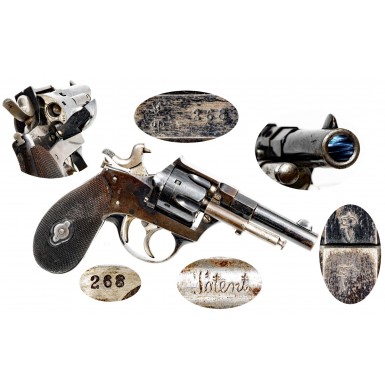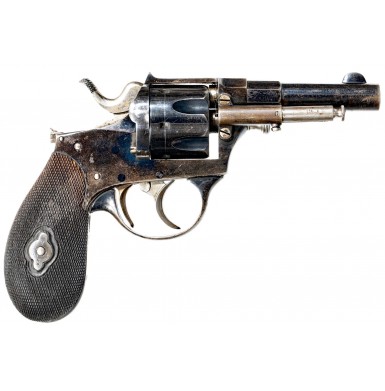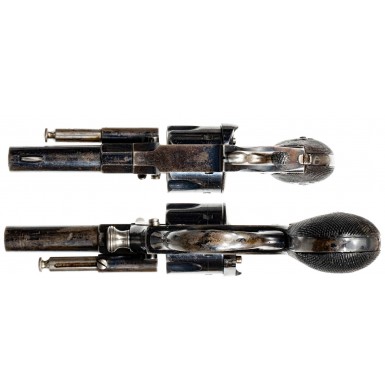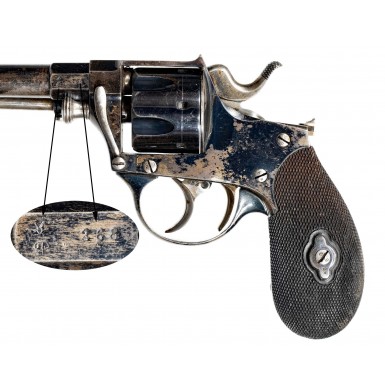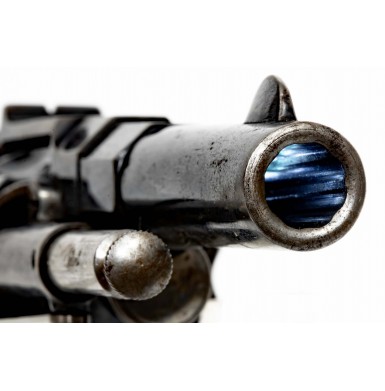Very Rare Pocket Sized Commercial Double Trigger Dreyse M83 Reichsrevolver
- Product Code: FHG-2247-SOLD
- Availability: Out Of Stock
-
$1.00
This is a VERY FINE condition example of a rare Pocket Sized Commercial German Model 1883 Ordnance Revolver. The larger and more common variant of the gun that this one was derived from is better known as the M83 Reichsrevolver. It is interesting to note that until 1879 and the adoption of the M79 Reichsrevolver (the direct ancestor to the M83), the standard military handguns in use by the Prussians and most of the other German kingdoms and states was primarily single shot, percussion muzzleloading pistols. Even though the Prussian military had been using incredibly advanced bolt action Dreyse needle rifles since their introduction in 1841, they felt little need to improve the arms of their cavalry, instead relying upon the lance and saber as their primary weapons, rather than the repeating cartridge handguns that had become a standard weapon for most western cavalry regiments by the early 1870s. With the exception of some Colt Model 1851 “Navy” percussion revolvers purchased by the Kriegsmarine (German Navy), the late 1870s found the state of Germanic military handguns firmly entrenched in the 1840s! A small handful of revolvers did see use with some of the Germanic state, like the Saxon M73 Revolver based upon the Smith & Wesson No 1 ½, but these were exceptions and not the norm.
The M79 Reichsrevolver was developed as the standard military handgun for use by the militaries of the four German kingdoms: Prussia, Bavaria, Saxony and Württemberg. It was 6-shot, single action revolver with a 7 1/8” round barrel with a small octagonal section at the frame juncture, and a reinforcing ring at the muzzle (often referred to as a “cannon” barrel). The guns were rather attractive with a deep chocolate colored rust browned finish. The revolver incorporated a safety lever on the left side of the frame and had a lanyard ring in the butt cap. The revolver was chambered for a 10.6x25R centerfire cartridge. The cartridge was loaded with a 262-grain lead bullet of about .44 caliber, propelled by a black powder charge with a muzzle velocity of 700 fps and 288 ft./lbs. of muzzle energy. The 10.6x25R is often compared to the S&W .44 Russian cartridge, which is nearly identical in size and power, and was initially produced by Ludwig Loewe & Company; the predecessor of DWM. The M79 was produced by three primary manufacturers. These were Gebrüder Mauser & Cie, who supplied the kingdoms of Bavaria and Württemberg, Franz V. Dreyse who supplied the kingdoms of Prussia and Bavaria, and the Suhl consortium of arms makers consisting of Spangenberg & Sauer, V.C. Schilling & Cie and C.G. Haenel & Cie, who supplied Prussia, Bavaria and Saxony. The revolver remained in production from its adoption in 1879 through 1883, with a total of 84,931 being produced.
In 1883, a more refined variant of the revolver was adopted as the M83 Reichsrevolver. The new gun retained the same basic design, with a single action mechanism and was still chambered for the 10.6mm x 25R cartridge. The most obvious change was the shortening of the barrel to 4 ¾” and the elimination of the cannon swell at the muzzle. The grip frame was also redesigned, making it somewhat more rounded and increasing the grip angle in relationship to the muzzle, and eliminating the buttcap on the bottom of the grip. Interestingly, the most deficient portion of the M79 design, the lack of an extraction or ejection system, was not addressed in the M83. Most M83 revolvers were blued rather than browned, and in the case of commercially produced guns for the private purchase of officers, the finish was often very impressive, rivaling that of Colt revolvers of the same period. A total of 132,656 M83 Ordnance Revolver were produced between 1883 and 1896. The large majority of the guns were manufactured by the Royal Prussian Armory at Erfurt, where some 95,000 of the guns (about 72%) of the guns were produced over 13-year period. Of those revolvers, the majority (92,500) were destined for issue to the Prussian military and the remaining 2,500 were issued to the state of Württemberg. Three contractors also produced the guns, the Suhl Consortium (V.C. Schilling and C.G. Haenel of Suhl), Waffenfabrik von Dreyse of Sömmerda and Gebrüder Mauser & Company of Oberndorf. The Suhl Consortium manufactured 22,296 (about 17%), Dreyse manufactured 13,860 (about 10%) and Mauser manufactured 1,500 (about 1%) of the M83 Ordnance revolvers produced. Of the guns produced by the Suhl consortium, 10,000 were delivered to the state of Prussia, 7,296 were delivered to the state of Bavaria and 5,000 were delivered to the state of Saxony. The Dreyse guns were delivered to the state of Prussia (13,000) and Bavaria (860) and the Mauser guns were all delivered to the state of Württemberg. These large and well-made revolvers remained the primary issue handgun to German state military forces (along with the earlier M79 Ordnance Revolver) until 1908, when they were superseded by the Parabellum-Pistole 1908, better known simply as “The Luger”. Even though the Luger replaced the M79 and M83 revolvers, these guns remained in use through the World War I era, mostly with second line and reserve troops. Unit marked revolvers are encountered from time to time, allowing the identification of the unit to which the gun was issued. Although considered obsolete by World War II, some M79 and M83 Reichsrevolvers are reported to have seen use by the French resistance during Nazi occupation. The Germans even pulled some Reichsrevolvers out of mothballs at the end of World War II, during the fight for Berlin.
The M83 was also produced in small quantities in a commercial variant. These guns were not a part of any official military contracts and were intended for sale to the “public”, although most of the customers were actually German officers who were acquiring their own sidearms. The most obvious difference between the majority of these “commercial” M83s and the military contract ones was a higher grade of finish, often a highly polished blue, and usually with checkered wood grips as well. A very small minority of the commercial guns had other differences or upgrades from the standard military models. Some utilized a double action, rather than a single action lock mechanism. Of these, some were also “double trigger” guns. Some also included a patent ejector system, a feature extremely uncommon with M83 revolvers. Some included a sliding safety on the upper rear edge of the grip frame. A very small number were also produced in a reduced frame size, making them more convenient for discreet “pocket carry” and were likely popular not only with officers who did not want to carry a heavy, full-sized service revolver, but also with police working in plain clothes or anyone who wanted a more concealable pistol. These reduced size revolvers were usually chambered in the smaller and less powerful 380 Revolver caliber, similar to the .38 Smith & Wesson and the British .38/200 cartridge, rather than the larger 10.6mm service cartridge.
One of the least common versions of these “commercial” M83 revolvers produced is the Pocket Sized Commercial M83 Revolver offered here, which remains in VERY FINE condition. The gun includes all of the rare and desirable features of a commercially produced M83 in a single package. It is a double action revolver with the rare, additional trigger; a feature that collectors refer to as a “double trigger” M83. The forward trigger is a conventional double action trigger however the rear trigger actually trips the sear. This can be compared to the exposed sear release revolvers of the earlier part of the 19thcentury like the Starr M1858 Revolver. The front trigger rotates and indexes the cylinder and cocks the hammer. Then pulling the forward trigger all the way to the rear it bumps the rear trigger and fires the gun. The gun can also be manually cocked than then fired in a single action mode, either by pulling the rear trigger or pulling the forward trigger far enough back to trip the rear trigger. Instead of the standard safety lever mounted on the left side of the frame of military M83 revolvers, a sliding, action locking safety is present at the top rear of the grip frame. Pushing the safety forward locks the action completely, while pulling it to the rear allows the revolver to function. The revolver also features a rare Patent marked ejector rod on the right side of the barrel, a feature very rarely found on M83 revolvers, even commercial ones. Finally, this is one of the reduced size “pocket” M83 revolvers that is scaled down by 26% from full size, according to Heinrich E. Harder, author of Der Reichsrevolver und seine Varianten. Harder shows an essentially identical example on page 166 of his book. The example pictured is noted to have been produced by Dreyse for the Innsbruck (Austria) firm of Johan Peterlongo and is so marked.
This example is almost entirely unmarked and shows no indication of what company made it. However, based on the fact that the gun is essentially identical to the one pictured in Harder’s book, it is safe to assume that it is a Dreyse produce revolver. The only markings are the word Patent on the ejector rod assembly, the serial number 268 which is found throughout either with all three digits or the last two, a pair of {CROWN}/V inspection marks and a small */P mark on the left barrel flat. The serial numbers are matching throughout with the full number found on the left barrel flat, the rear face of the cylinder, on the top edge of the cylinder arbor pin flat and inside both grips. The balance of the parts are marked with the last two number of the serial number, 68, which appear practically everywhere, including the screw heads and the mainspring. Both the octagonal and round sections of the barrel are stamped on their tops with {CROWN}/V inspection marks, in compliance with the German Shelling Act of 1891, indicating production prior to that act and the passing of inspection circa 1891.
This compact M83 Commercial Revolver measures about 7 ½” in overall length with a 3 3/8” barrel and a 1 1/8” long, 6-shot fluted cylinder. The bore of the revolver is rifled with 8 narrow grooves that appear to be slightly more than half the width of the lands. As noted, the revolver retains in about VERY FINE condition. The gun retains about 65%+ of its original high-polished blue finish. The barrel and frame both retain about 30%-40% thinning and worn original blue, while the cylinder retains about 85%+ original blue. The rear trigger retains about 30% thinning yellow straw finish, with some minute traces on the front trigger and the hammer. The metal is almost entirely smooth with no visible pitting. There is some scattered minor surface oxidation as well as some freckled discoloration and oxidation shot through the thinning blue. The few markings on the gun remain clear, crisp and fully legible. The action of the revolver is extremely crisp and tight and functions perfectly. The revolver times, indexes and locks up perfectly. Both triggers and both the single action and double action modes function perfectly. The ejector system functions smoothly and correctly, and the safety mounted on the upper rear of the gripstrap functions correctly as well. The bore of the revolver remains in about FINE condition. It is mostly bright with crisp rifling along its entire length. There is some scattered minor oxidation and frosting in the grooves, as well as some scattered areas of minor discoloration and flaky oxidation. A good brushing would probably improve the bore even more, possibly bringing it up to about excellent. While there is some pinpricking scattered here and there, the bore is essentially free of any real pitting. The checkered wood grips remain in about FINE condition as well and retain crisp checkering over most of their surfaces. The grips are solid and free of any breaks, cracks or repairs. The grips shows some scattered wear and scattered bumps, dings and handling marks. The most noticeable one is a fingertip-sized push in the right grip, above the screw escutcheon. There is some minor wear and flattening to some of the checkering due to handling and use. There is some minor warping at the bottom edges of the grips and a couple of very tiny splinters missing along the bottom at the inner edge of the grip frame, but these are so minor they are barely noticeable.
Overall this is a really wonderful and crisp example of a very scarce Pocket Sized Commercial M83 Reichsrevolver. These reduced size revolvers are extremely scarce, and the gun includes a large number of other rare M83 features, including the double trigger system, patent ejector system and grip frame safety. This would be a wonderful addition to any collection of 19th century Imperial German revolvers and would be a great piece to add to a display of an early WWI period German officer’s items. The gun is 100% complete, correct and original and retains a large amount of original finish. It will be a wonderful piece to add to your collection and I am quite sure you will be quite proud to display it.
SOLD
Tags: Very, Rare, Pocket, Sized, Commercial, Double, Trigger, Dreyse, M83, Reichsrevolver

